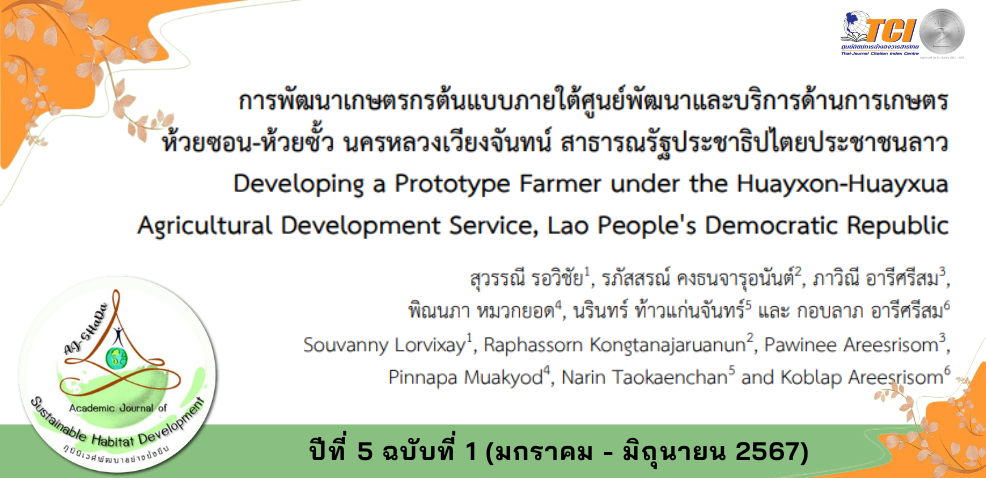Developing a Prototype Farmer under the Huayxon-Huayxua Agricultural Development Service, Lao People's Democratic Republic
Main Article Content
Abstract
The objectives of the study were to: 1) explore general context in the operation of model farmer; 2) analyze factors contributing to the model farmers development; 3) explore problem encountered in the operation; and 4) investigate guidelines for developing the model farmers. The sample group consisted of 78 and 16 model farmer households in Na Xaythong and Sangthong districts, respectively. They were under the Huayson – Huaysua Agricultural Service and Development Center, Vientiane, Lao P.D.R. Questionnaire and interview schedule were used for data collection and analyzed by using descriptive statistics and content analysis
Results of the study revealed that most of the model farmers were males, Buddhists, 41–50-year-old and lower-secondary school graduates. They were married and had 4 household members. Most of the model farmers had more than 15 years of experience in farming, 2 farming workforce and less than 10 rai of farmland. Their household income range was 50,001 - 100,000 bath/year but they did not have saving and debts. Most of the model farmers spent their own capital and they were members of large agricultural plots of the center. Their main agricultural objective was subsistence and the surplus agricultural yields were sold. The model farmer were supported by the center and most of them had attended a training. Findings showed that the model farmers had a highest level of agricultural practice ( =4.27) and, as a whole, they had a highest level of opinions about the practice (
=4.48). this included the following: learning plot, learning curriculum, and learning station. Also, there was a highest level of practice in the center management (
=4.53), extending results into practice of the center (
=4.23) and network connection of the center (
=3.86). Factors contributing to the model farmers development consisted of internal and external factors. The farmers should be improved in terms of the training station (management) and operational planning (thinking the product to the market). The latter could be responsive to good promotion. The following were problem encountered: old basic structure and demonstration tool; lack of budgets repairing/rehabilitation; learning curriculum was not effective enough; lack of quality personnel; supporting staff had low educational attainment; and the specific academic enhancement of supporting staff was not so strong as it should be, For the model farmers, they lacked of production planning based on agricultural extension activities, processing, and market linkage. The following were suggestions: adding potential development in management and planning; strengthening effective working of personal/supporting staff; and uplifting the center to be a One - Stop Demo Center.
Article Details

This work is licensed under a Creative Commons Attribution-NonCommercial-NoDerivatives 4.0 International License.
References
ณิชาภัทร ดุลยกุล. (2564). แนวทางการพัฒนาเกษตรกรต้นแบบของศูนย์เรียนรู้ การเพิ่มประสิทธิภาพการผลิตสินค้าเกษตร (ศพก.) จังหวัดนราธิวาส. (วิทยานิพนธ์ปริญญาวิทยาศาสตรมหาบัณฑิต). มหาวิทยาลัยแม่โจ้, เชียงใหม่.
ดลมนัส กาเจ. (2558). เบิ่งลาวไปศูนย์ห้วยซอน-ห้วยชั้วชมโครงการ 21 ปีแห่งความสำเร็จ. สืบค้นเมื่อ 21 พฤษภาคม 2566, จาก https://www.komchadluek.net/kom-lifestyle/210800
นิศา ชูโต. (2551). การวิจัยเชิงคุณภาพ. กรุงเทพ: พริ้นต์โพร.
ภีมภณ มณีธร. (2566). ปัญหาและอุปสรรคของกลุ่มเกษตรกรท้องถิ่นในจังหวัดเชียงใหม่ในการพัฒนาผลิตภัณฑ์เพื่อต่อยอดสู่ประโยชน์เชิงพาณิชย์และสาธารณะภายใต้ประชาคมเศรษฐกิจอาเซียน. วารสารปัญญาภิวัฒน์, 15(1), 61-75.
มนสิช สิทธิสมบูรณ์. (2550). ระเบียบวิธีวิจัย. พิมพ์ครั้งที่ 8. พิษณุโลก: คณะศึกษาศาสตร์ มหาวิทยาลัยนเรศวร.
ศูนย์พัฒนาและบริการด้านการเกษตรห้วยซอน-ห้วยซั้ว. (2565). ข้อมูลตัวเลขกลุ่มสมาชิกเกษตรกรของศูนย์พัฒนาและบริการด้านการเกษตรห้วยซอน-ห้วยซั้ว 1 กันยายน 2565. นครหลวงเวียงจันทน์: ศูนย์พัฒนาและบริการด้านการเกษตรห้วยซอน-ห้วยซั้ว.
สำนักงานคณะกรรมการพิเศษเพื่อประสานงานโครงการอันเนื่องมาจากพระราชดำริ. (2542). แนวคิดและทฤษฎี การพัฒนาอันเนื่องมาจากพระราชดำริ ในพระบาทสมเด็จพระเจ้าอยู่หัว. กรุงเทพฯ: สำนักงานคณะกรรมการพิเศษเพื่อประสานงานโครงการอันเนื่องมาจากพระราชดำริ.
สำนักงานคณะกรรมการพิเศษเพื่อประสานงานโครงการอันเนื่องมาจากพระราชดำริ. (2555). แนวคิดและทฤษฎีในพระบาทสมเด็จพระเจ้าอยู่หัว. กรุงเทพฯ: สำนักงานคณะกรรมการพิเศษเพื่อประสานงานโครงการอันเนื่องมาจากพระราชดำริ.
สำนักมาตรฐานการศึกษา. (2545). ชุดการเรียนรู้ด้วยตนเอง ชุดวิชาการวิจัยชุมชน. กรุงเทพฯ: เอส.อาร์.พริ้นติ้ง.
สุภางค์ จันทวานิช. (2556). การวิเคราะห์ข้อมูลในการวิจัยเชิงคุณภาพ. กรุงเทพฯ: สำนักพิมพ์แห่งจุฬาลงกรณ์มหาวิทยาลัย.
อนุลม ตุนาลม. (2558). ยุทธศาสตร์การจัดการน้ำเพื่อการเพาะปลูกในพื้นที่ชลประทานลุ่มน้ำห้วยชวน-ห้วยชั้ว นครหลวงเวียงจันทน์ สาธารณรัฐประชาธิปไตยประชาชนลาว. (วิทยานิพนธ์ปริญญาปรัชญาดุษฎีบัณฑิต). มหาวิทยาลัยราชภัฏอุดรธานี, อุดรธานี.
Likert, R. (1932). Technique for the Measurement of Attitudes. Arch Psychology, 25(140), 1-55.


